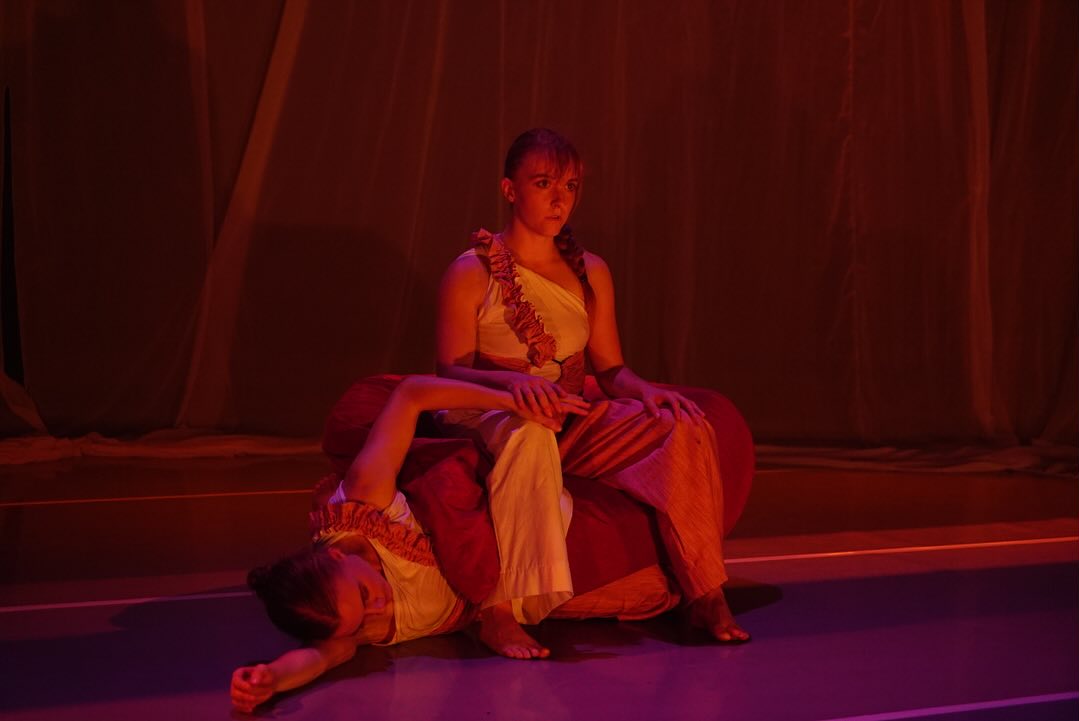El Yule
From the womb, faceless entities clinging together for dear life, to first steps, first fights, birthday cakes (singular) and shared gym memberships; Rituals of Similarity is a fascinating reflection of two people’s shared journey through a world beleaguered by individualism. It evokes nostalgia for the quirks and quagmires of our sibling and familial connections, and contemplates the ever-evolving construction of the self in response to those around us; the people that we are like, or not like, seek to emulate or separate ourselves from.
Natasha and Brittany are gorgeous dancers, and the choreography they have created together is masterful. Dynamic, ever-evolving, clean and intricate with plenty of space for organic interactions, intriguing compositions that explore the tensions between leaning on and away from one another. A fleeting moment I savour is when one twin stood and took their first steps while the other lay on their stomach clasping their ankles - a concise reflection of symbiotic influence and development, supporting and holding one another back. The cradling of one another’s heads is a lovely recurring motif that oscillates between a comforting caress and a deft redirection. As often as there is active resistance there is also relinquishing trust. While watching, it struck me what an incredible rarity and a privilege it is to witness a performance refined by a lifelong relationship between the performers; their trust in one another, shared references and unspoken understanding, not to mention their physical symmetry, is incredibly and uniquely compelling.
While unspoken communication is a staple of dance shows, the use of spoken words poses a risk of being jarring and disruptive. Rituals of Similarity uses this to its advantage in the most striking sequence of the show, where, after breaking apart from one another to sit on opposite sides of the stage, the twins launch into a vent in eerie unison. This tangential monologue, accented by frenetic movements, calls out all the crude and unthinking comments they have encountered, by which they are compared, conflated, confused, and compressed as a "2-for-1" deal. Their vocal and physical delivery is crisp, sarcastic, comedic and astoundingly in sync.
The set is minimal in a way you might expect from a dance show (or indeed a Fringe show, sandwiched between other productions and stressfully short pack-ins/outs). Though minimal, where designer Talia Pua excels is in textures. Tapere Nui’s black box has become a white cocoon, a blank canvas for the liminal spaces the performers move through. The sheer white drapes work beautifully to catch the performer's shadows, while also bringing to mind a vaguely recalled term from high school biology - the amniotic sac: a pair (coincidentally) of membranes, also known as the “bag of waters”, that holds and sustains life as it grows.
The birthday cake, a gloriously sticky chocolatey mess, is another lovely sensory representation of shared celebration and competition: savoured, hacked at, and smeared about.
Lucien Johnson’s soundscapes fuse the ambient sounds of the natural world; the pulses and hum of being in utero, birdsong, and the cries of excitable children, with gritty static, heavy rumbles and clashes that support and direct the choreography through lulls and surges.
The costuming is crisp and impactful, soft in its use of a pink and white palate, and striking in its structural and textural details that capture the tension of being pulled both toward and away. Costume designer Zoë McNicholas has expertly encapsulated the symmetry and asymmetry of twinhood, down to the mirrored pink and white trouser legs and the DNA chain of ruched pink fabric angling down from opposing shoulders to the abdomen, a shared centre which calls to mind the umbilical cords that have connected these performers since they “met before birth.” All of these details also beautifully enhance the shapes and lines of the choreography - it is contemporary dance costuming done oh so right.
The descriptor I keep returning to in summarising this show is ‘articulate’ - which is something dance productions can sometimes struggle with, given the endlessly interpretative nature of movement. It’s not the sort of dance show that you and your friends walk away from with five contrasting interpretations (not that there is anything wrong with that!); it is clear, defined, and artfully explored. Rituals of Similarity is a well-conceptualised, beautifully performed, and cleanly executed production that deftly balances the tensions it holds with weight, lightness, tenderness and humour. The entire creative team demonstrates impactful utilisation of staging and spatial composition, contrast, and texture, which unifies the performance.
This show is so nice, I saw it twice.
Rituals of Similarity has finished their season in the Fringe Festival, but you can find more information about their upcoming shows through their Facebook or website.









